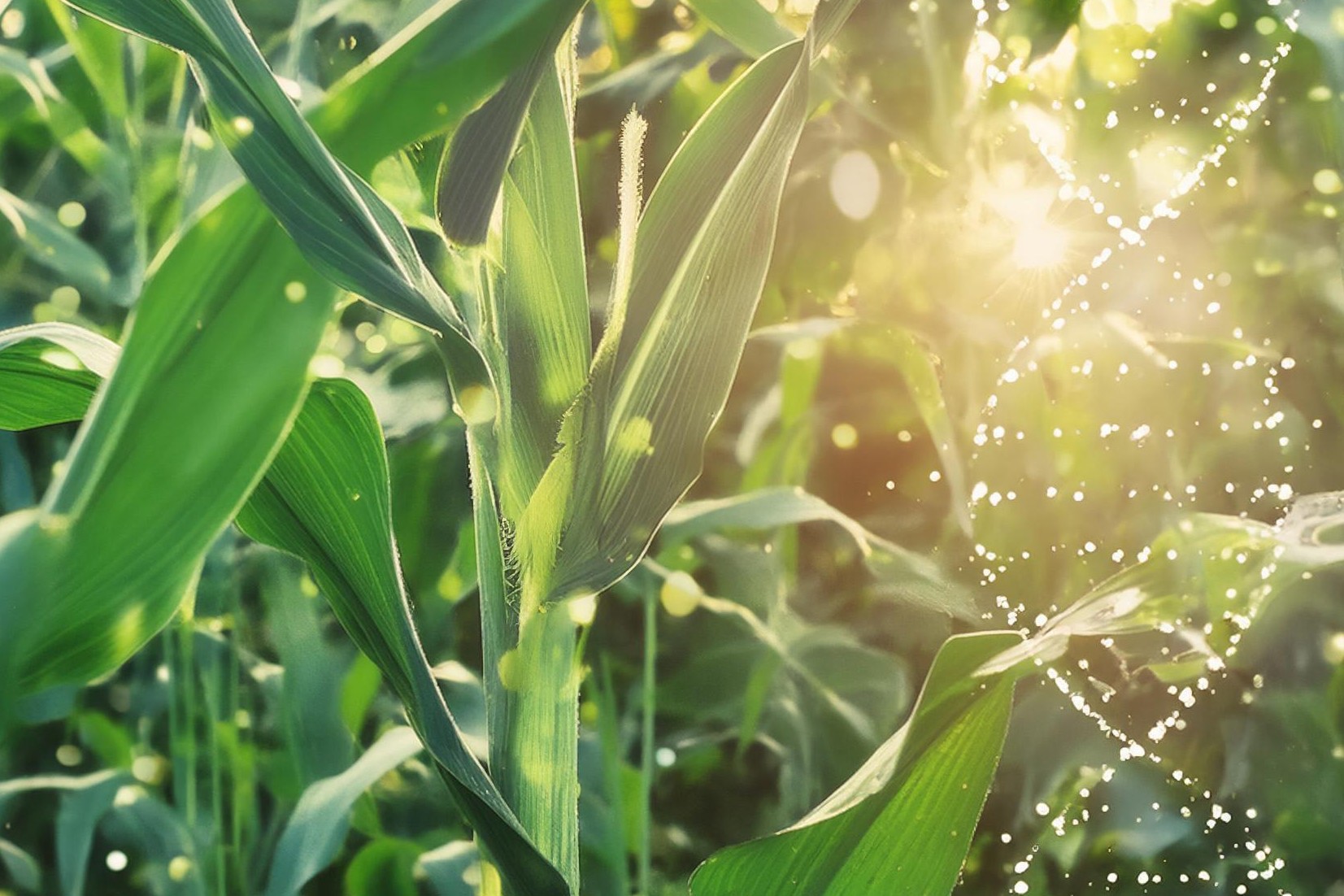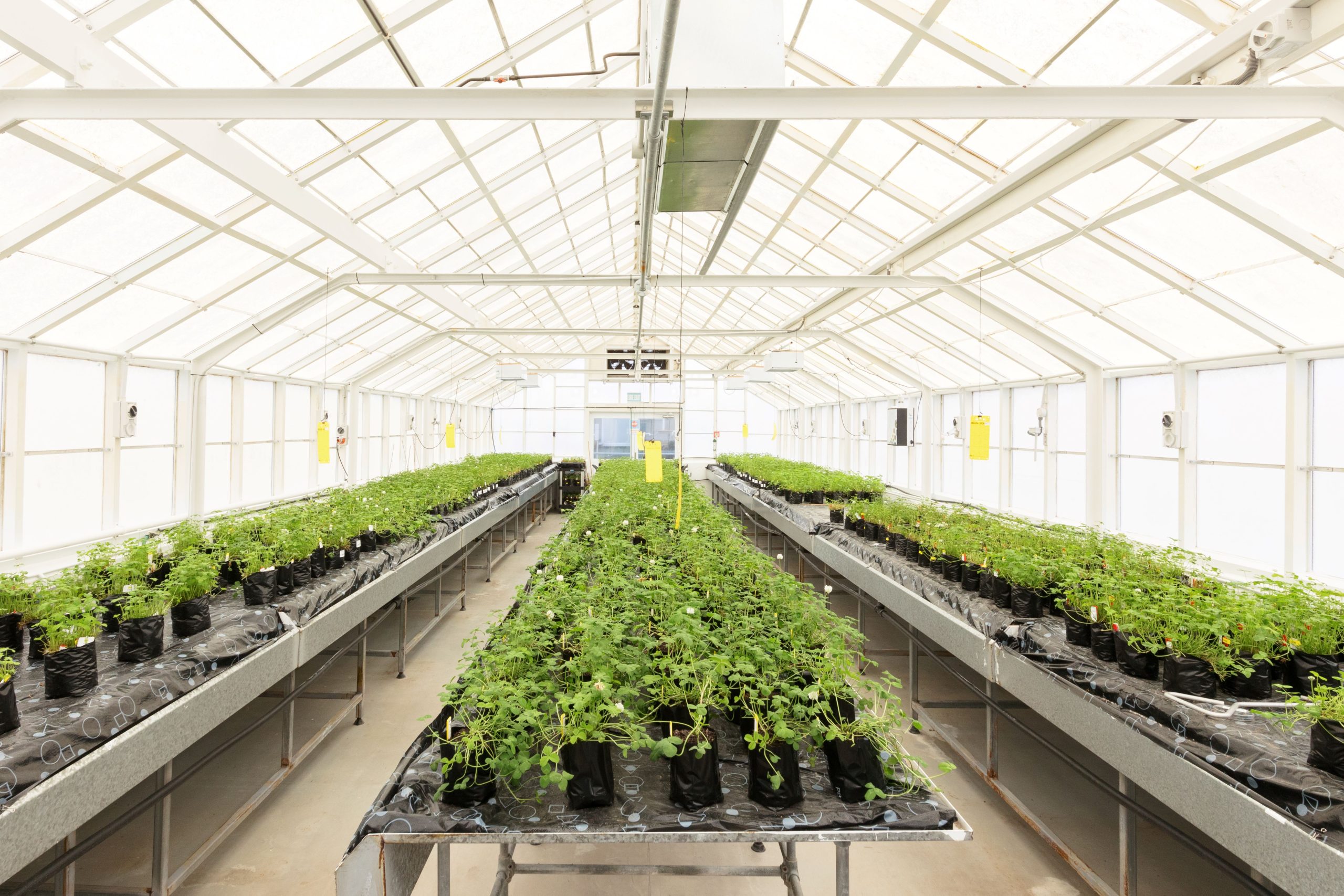What's in the pipeline
Researchers are busy seeking a wide range of solutions for reducing or eliminating methane and other Greenhouse Gas emissions from agriculture. Anne Lee reports.
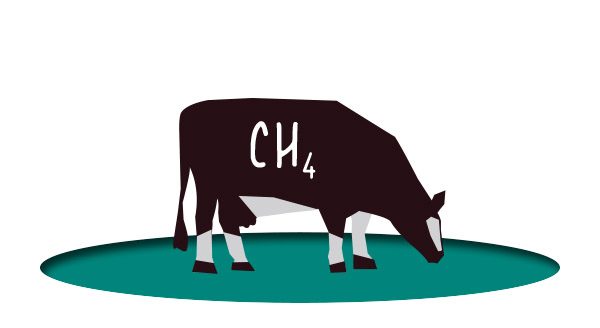
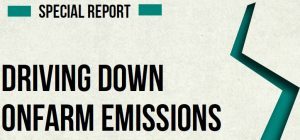 With farmers set to start paying for greenhouse gas (GHG) emissions from 2025 the race is on to find viable ways to materially cut methane and nitrous oxide emissions without cutting milk or meat production.
With farmers set to start paying for greenhouse gas (GHG) emissions from 2025 the race is on to find viable ways to materially cut methane and nitrous oxide emissions without cutting milk or meat production.
Research in New Zealand and around the globe has been going on for decades but to date there are no silver bullets offering significant reductions available for use in NZ’s dairy herds in a pastoral grazing situation.
Nitrous oxide reductions are limited but are available – the problem is they don’t give the major hit needed to substantially cut total emissions.
Don’t despair though, some hopefuls are emerging from a myriad of possibles. They’re edging closer to achieving “adoptable” status but still have hurdles to get over if they’re to be deemed farm system fit, efficacious and economic – to name but a few of the criteria to allow them to be included in farmers’ GHG inventory calculations. Scientists are investigating numerous methane mitigations but for our pastoral grazing systems one of the biggest hurdles is getting enough of any “treatment” into the rumen for long enough so it’s timed with feed ingestion. In farm systems where cows are fed indoors on total mixed rations (TMR), treatments can be mixed with the feed and therefore present in every mouthful.
Bovaer, (3-NOP), is already being used in the Netherlands on 200 dairy farms in a pilot trial with dairy co-op FrieslandCampina.
Asparagopsis seaweed is also getting closer to commercial availability and while, like Bovaer, it shows significant methane reductions in a TMR diet, work is underway to find out how it can be incorporated into our farm systems. (See story page 52)
Pastoral Greenhouse Gas Research Consortium (PGgRc) general manager Mark Aspin says a recent review of where research into mitigations is at, as depicted in figure one, shows just how many options have been under investigation and how close they are to then leaping the fence, making it past the criteria for implementation.
A multi-million dollar research programme has successfully found enough genetic variation and heritability in sheep for a low methane emissions breeding value to be developed.
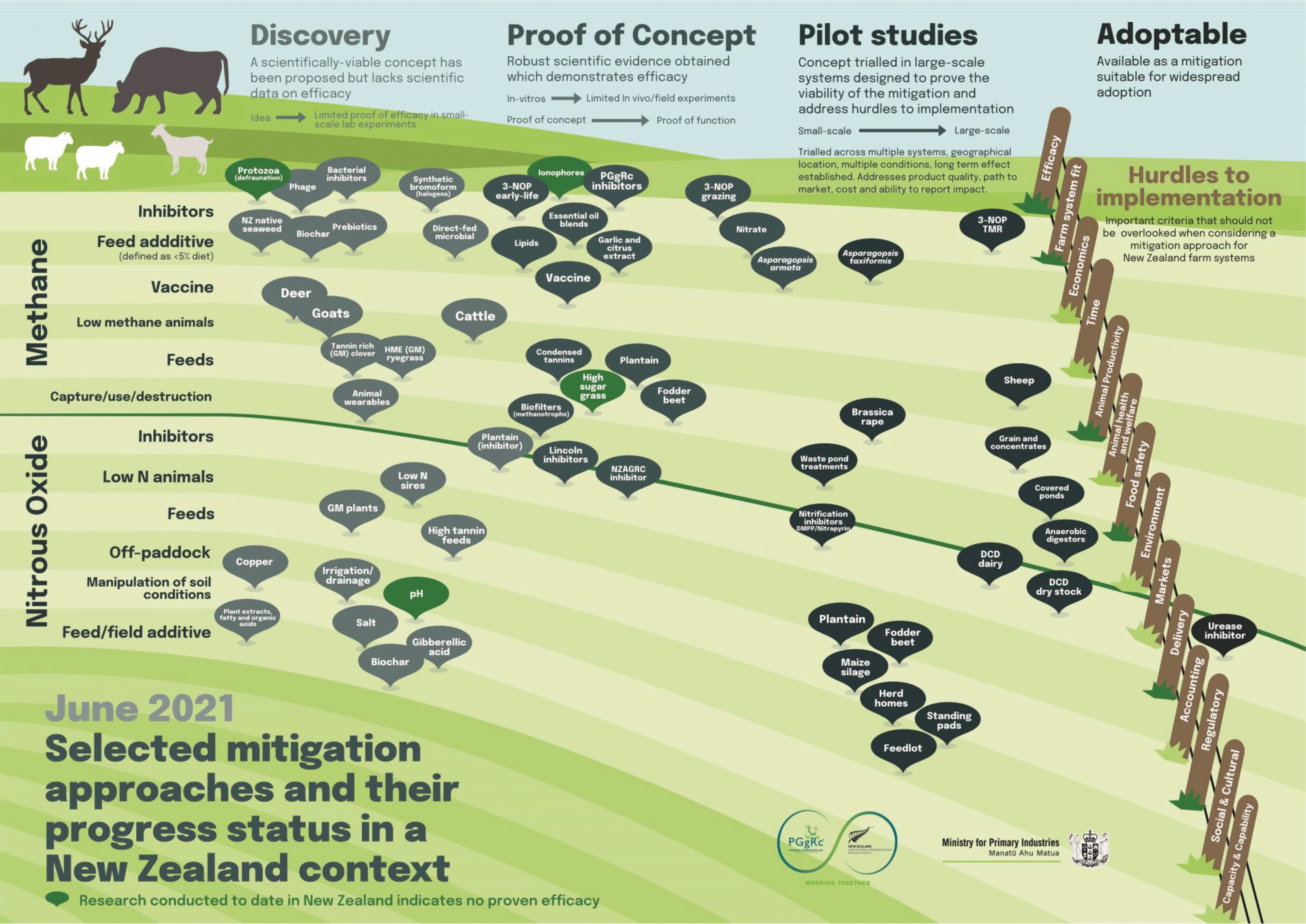
Similar work is underway with dairy cattle. (story page 54)Other mitigations close to leaping the fence include grain and concentrates, known to help lower methane emissions, but they’re not the key feed input into NZ dairy systems.
Likewise, covering effluent ponds and putting in anaerobic digesters can also capture methane losses but these losses make up a relatively small percentage of the whole farm’s methane loss. PGgRc’s two major research projects showing promise of significant reductions, but yet to make it to pilot farm scale studies, are the development of methane inhibitors and a vaccine.
It’s involved learning more about the methanogens and being part of a global effort to sequence the genomes involved.
Much of the research has focused on identifying the enzymes within the methanogens that are part of the process of methanogenesis – turning hydrogen and carbon dioxide into methane. Turns out there are about 125 enzymes and 200 genes involved in methanogenesis and from there scientists have identified 25 key enzyme proteins. Knock out any one of the proteins and the methanogenesis process stops. The research has involved “in-silico” screening – the use of powerful computers to analyse millions of different compounds and combinations as potential enzyme busting candidates.
About 140,000 have been further screened producing thousands of “hits” as to possible compounds and from there the researchers have then applied further criteria and in-vitro (in the lab) chemical tests to whittle it down further.
Four-day, in-vivo (in the animal), respiration chamber trials on sheep have then been used and have identified five leading compounds that can inhibit methane production by 30% without impacting the rumen’s other processes.
Further tests involving 16-day animal trials on sheep have led to the identification of two classes of inhibitors.
Having two classes will help ensure the effects last in the rumen and the compounds remain efficacious.
Compounds also have to have the right chemistry for delivery and low residues.
Slow-release bolus capsules could be a practical method of delivering inhibitors into the rumen but so too are pelletised formulations fed during milking or available out in the paddock.
Getting formulations and dose rates correct, trialling various methods of delivery and carrying out field-scale studies will all be part of continuing research.
Mark says the work so far has involved some very deep science but discussions with commercial partners are underway, concurrently with further research.
At the same time PGgRc and its industry partners (including DairyNZ) are working with government to establish a regulatory pathway so the products can be registered as safe to use and so that methane reductions can be included in NZ’s and farmers’ GHG inventory.
Vaccine
Studies to find a vaccine that targets methanogens have been underway in NZ since 2007 through the PGgRc with AgResearch leading the science.
The theory is that a vaccine containing antigens – likely a protein related to the methanogens or whole methanogens – would be used to create an immune response. Once vaccinated with the protein antigen the animal would produce antibodies in the blood, mucous membranes and saliva.
The animal would swallow the saliva – cows produce up to 60 litres of saliva a day – flushing the antibodies into the rumen where they can then target the methanogens. Mark says scientists have been successful in finding antigens that set up an immune response in the animal with antibodies created that specifically target methanogens.
They’ve also been successful at finding those antibodies in the saliva in large numbers and they’ve found antibodies in rumen fluid. But to date they haven’t found that’s translated to vaccinated animals producing significantly less methane.
“The positive thing is researchers haven’t found a reason it can’t work so that science is ongoing,” he says.
One of the positives to come out of the Covid-19 pandemic could be lessons for the development of a methane vaccine.
Mark says while scientists don’t believe the mRNA vaccine technology itself will be useful, there are lessons from the huge focus on the Covid vaccination development programme that may help speed the methane vaccine programme.
At this stage though a vaccine is likely at least 10 years away.
“If we did manage to find antigens that give us the response we need though, getting the vaccine out to farmers as a product would only take about three or four years because the regulatory process for vaccines is already there.”
PGgRc nhibitors
The PGgRc methane inhibitor programme, based at AgResearch, has been running for 10 years and while it’s looking promising it’s likely any commercially available inhibitor will be at least five to seven years away, Mark says.
The programme’s aim is to find inhibitors that can effectively reduce the amount of methane produced by grazing animals by 30% while ensuring the inhibitor causes no animal welfare issues, doesn’t limit productivity, is food safe so the animals and their products such as milk can be used for human consumption and is cost effective.
Mark says any mitigations must support NZ’s export markets and international regulations. The inhibitor study is a huge scientific undertaking, using world class science, and NZ’s efforts are also part of global collaborations to find solutions for ruminants farmed and wild. It’s targeted two ways of limiting methane production.
1. Finding a way to break down the cell walls or interrupt critical cell functions of the methanogens thereby attacking them directly.
2. Finding compounds that interfere with the process of methanogenesis itself.
Working on the pipeline
The Pastoral Greenhouse Gas Research Consortium (PGgRc) is a joint venture that has managed much of the funding for agricultural GHG research in New Zealand.
It includes eight sector partners and works in collaboration with the government.
Its eight partners include DairyNZ, Fonterra, AgResearch, Beef + Lamb New Zealand, DEEResearch, Fertiliser Association of New Zealand, Landcorp Farming (Pamu) and PGG Wrightson.
Its government associate members are the Ministry for Primary Industries, the Ministry of Business Innovation and Employment and NIWA along with the NZ Agricultural Greenhouse Gas Research Centre (NZAGRC).
The NZAGRC has nine member organisations including AgResearch, DairyNZ, Manaaki Whenua Landcare Research, Massey University, Lincoln University, NIWA, PGgRc, Plant and Food Research and Scion.
PGgRc and NZAGRC have worked in partnership since 2009 and have been the main players in advancing opportunities for NZ farmers to reduce agricultural GHG emissions.
Protozoa, phage or virus, bacterial inhibitors
Protozoa are one of the many groups of organisms present in the rumen. They feed on other organisms and produce hydrogen as part of that process. It was thought that if protozoa numbers were reduced there would be less hydrogen available for the methanogens and this in turn would cut the amount of methane produced. While it was achieved experimentally, the difficulty, cost and challenge of “defaunation” or removing the protozoa means it’s extremely difficult to do and maintain.
Phages or viruses were also investigated as a means to kill off methanogens but again it has been difficult to harness them for use.
It was a similar story for using rumen bacteria – some could kill off methanogens, but it is difficult to do at scale.
Biochar
Australian studies have shown biochar can decrease enteric methane emissions in in-vitro, simulated rumen experiments but it hasn’t been taken further to pilot studies using animals. It has also been shown in laboratory studies to reduce nitrous oxide emissions when mixed into soils.
Lipids, essential oils and blends
Research through PGgRc has reported higher dietary lipid concentrations in cattle can reduce methane emissions by up to 5% for each 1% increase in lipid content. Grasses such as ryegrass typically contain 2-4%.
Cattle will tolerate lipid concentrations in their diet of up to 7% so there could be an opportunity to lower methane emissions by about 20% by adding lipids (fats/ oils) into the diet. However, milk taint and cost are both considerations.
Mootral is an agritech company based in the UK and Switzerland. It has developed a feed additive from a specialised garlic and citrus blend and carried out studies that claim a 30% reduction in methane emissions from cows supplemented with the additive fed in a pelletised form.
No changes to milk taste or texture have been detected. Based on a preliminary short term, in vitro study published in 2021 in Frontiers in Veterinary Science, addition of the Mootral product resulted in methane gas reductions and a drop in methanogen populations. www.mootral.com
Animal wearables
A novel idea not being pursued in NZ by the PGgRc but works by putting a halter on the cow with a device that sits above the nose.
The concept involves the device capturing a proportion of the methane as it’s burped up by the cow before it escapes into the atmosphere.
Typically, methane is burned or flared off if it’s captured with the aim of destroying it but that’s not likely to be practical – dragon cows probably wouldn’t be a goer.
However, there are companies developing technology which can deal with the methane in a more practical way. Zelp is a United Kingdom-based company which uses technology housed on a harness worn by cows which captures the methane and oxidises it.
The oxidation products are water vapour, carbon dioxide (CO₂) and energy.
The amount of CO₂ produced has less warming potential than the methane and the energy released in the process is captured and recycled to help power the technology.
The wearable harnesses include sensors that capture data that can then be used to monitor animal health and welfare information such as rumination and heat detection as well as methane production.
Funding for the devices is supported by companies and governments’ environmental initiatives. www.zelp.co
Condensed tannins
High tannin levels in plants such as Lotus corniculatus (Birdsfoot trefoil) have been shown to reduce methane production in animals consuming them – usually in the range of 10-15%.
The problem is most of the plants with high tannin levels are difficult to maintain in a pasture. Even if they are grown and grazed separately it’s not easy to set up a grazing system around them and for some, they aren’t present in a growing state throughout the year. They may be useful in genetic modification breeding programmes but that’s not currently possible in NZ.
Forages
Plantain and fodder beet have been shown to help reduce methane production but they need to make up more than 70% of the diet. More work into their effects on methane is underway as part of studies into their known abilities to reduce urinary nitrogen concentrations and help lower nitrous oxide emissions. That’s why they sit in the proof of concept area for methane reduction but pilot studies for nitrous oxide.
High sugar ryegrass varieties have been linked with lower methane emissions but similar methane reductions have also been associated with some tetraploid ryegrass cultivars and to date no published research has been able to show the definitive cause and effect of high water soluble carbohydrate levels and reduced methane emissions from animals grazing on them.
Effluent pond methane reductions
Lincoln University scientists in conjunction with Ravensdown have developed effluent treatment systems using iron sulphate which can cut methane emissions from effluent ponds by about 99%.
Typically effluent ponds make up about 5% of a farm’s total methane emissions profile. Presence of iron sulphate in effluent boosts levels of specific naturally occurring bacteria which happen to limit methanogen populations.
The additive also keeps the redox potential (the measure of how easily a molecule accepts electrons) at a level where the methanogenesis reaction won’t occur.
Nitrification inhibitors
Nitrification inhibitors stop or limit the natural process in the nitrogen cycle that see ammonia and ammonium oxidised to nitrite and nitrate. That leaves less nitrite to be denitrified to the very potent GHG, nitrous oxide.
Ravensdown’s nitrification inhibitor, Eco-n which used the compound DCD, was successful at lowering nitrous oxide emissions but because the active ingredient was detected in milk and is not included in the international Codex for food products, it was withdrawn from the market. Other nitrification inhibitors are being investigated by scientists at Lincoln University and through a NZAGC study. Because nitrous oxide is a potent GHG it’s CO₂e are high and any mitigations stand to give farmers good total farm reductions.


